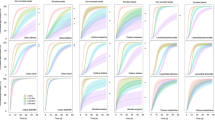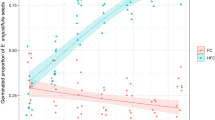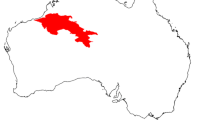Abstract
Responses of seed germination to air temperature, water potential, light, and smoke were studied in the laboratory for seeds of the invasive bunch grass Pennisetum ciliare (L.) Link (syn. Cenchrus ciliare L.; buffel grass). First introduced to North America during the mid-twentieth Century for establishing pastures, this African bunch grass has become an invasive species of concern. Across all the experiments conducted, a low germination was observed for P. ciliare fascicles that never exceeded 30 % at 21 days after sowing. Optimal day/night air temperatures for germination, controlled with an environmental chamber, were 25/15 and 30/20 °C, while extreme temperatures of 15/5 and 45/35 °C inhibited germination. By sowing seeds of P. ciliare under different water potentials, created with aqueous solutions of polyethylene glycol, an optimum of −0.03 MPa led to the highest germination, while no germination was observed at −1.0 MPa. Monochromatic optical filters were utilized to germinate seeds under various wavelengths, of which red (650 nm) and far red (730 nm) led to the highest germination. In addition, seeds that were incubated in the dark had higher germination than those incubated under white light. Incubation in smoke water, which can stimulate germination of pyrophytic species, resulted in a marginal inhibition of germination compared with imbibition with distilled water.



Similar content being viewed by others
References
Amritphale D, Iyengar S, Sharma RK (1989) Effect of light and storage-temperature on seed-germination in Hygrophila-auriculata (Schumach) Haines. J Seed Technol 13:39–44
Angevine M, Chabot B (1979) Seed germination syndromes in higher plants. In: Jain S, Johnson G, Raven P, Solbrig O (eds) Topics in plant population biology. Macmillan Press, New York, pp 188–202
Arriaga L, Castellanos VAE, Moreno E, Alarcon J (2004) Potential ecological distribution of alien invasive species and risk assessment: a case study of buffel grass in Arid Regions of Mexico. Conserv Biol 18:1504–1514. doi:10.1111/j.1523-1739.2004.00166.x
Baskin CC, Baskin JM (2014) Seeds: ecology, biogeography, and evolution of dormancy and germination. 2nd edn. Academic Press/Elsevier. 10.1016/B978-0-12-416677-6.00013-5
Bhattarai SP, Fox J, Gyasi-Agyei Y (2008) Enhancing buffel grass seed germination by acid treatment for rapid vegetation establishment on railway batters. J Arid Environ 72:255–262. doi:10.1016/j.jaridenv.2007.06.010
Bonvissuto GL, Basso CA (2007) Germination of grasses and shrubs under various water stress and temperature conditions. Phyton-Int J Exp Bot 76:119–131
Brady NC, Weil RR (1996) The nature and properties of soils, 11th edn. Prentice Hall, Upper Saddl River
Brown NAC, van Staden J (1997) Smoke as a germination cue: a review. Plant Growth Regul 22:115–124. doi:10.1023/A:1005852018644
Castellanos A, Yanes F, Valdez-Zamudio D (2002) Drought-tolerant exotic buffelgrass and desertification. In: Tellman B (ed) Weeds across borders: proceedings of a North American conference. Arizona-Sonora Desert Museum, Tucson, pp 99–112
Comisión Nacional para el Conocimiento y Uso de la Biodiversidad (2006) Especies Invasoras de Alto Impacto a la Biodiversidad: Prioridades en México. CANEI/CONABIO/SEMARNAT, Mexico
Comisión Nacional para el Conocimiento y Uso de la Biodiversidad (2010) Estrategia Nacional de Especies Invasoras en México: Prevención, Control y Erradicación. CONABIO, Mexico
Cox JR, Martin MH, Ibarra FA, Fourie JH, Rethman NFG, Wilcox DG (1988) The influence of climate and soils on the distribution of 4 African Grasses. J Range Manag 41:127–139
Cruz-Cardenas G, Lopez-Mata L, Alberto Ortiz-Solorio C, Luis Villasenor J, Ortiz E, Teodoro Silva J et al (2014) Interpolation of Mexican soil properties at a scale of 1:1,000,000. Geoderma 213:29–35. doi:10.1016/j.geoderma.2013.07.014
DaCosta M, Huang B (2009) Physiological adaptations of perennial grasses to drought stress. In: de la Barrera E, Smith WK (eds) Perspectives in biophysical plant ecophysiology: a Tribute to Park S Nobel, Universidad Nacional Autónoma de México. p. 169–90
Datta S, Seen S (1987) A comparison of the germination characteritics of Desmodium species. Acta Botanica Hungarica 33:125–131
de la Barrera E (2008) Recent invasion of buffel grass (Cenchrus ciliaris) of a natural protected area from the southern Sonoran Desert. Revista Mexicana de Biodiversidad 79:385–392
de la Barrera E, Castellanos AE (2007) High temperature effects on gas exchange for the invasive buffel grass (Pennisetum ciliare [L.] Link). Weed Biol Manage 7:128–131. doi:10.1111/j.1445-6664.2007.00248.x
de la Barrera E, Nobel PS (2003) Physiological ecology of seed germination for the columnar cactus Stenocereus queretaroensis. J Arid Environ 53:297–306. doi:10.1006/jare.2002.1050
de la Barrera E, Pimienta-Barrios E, Schondube JE (2009) Reproductive ecophysiology. In: de la Barrera E, Smith WK (eds) Perspectives in biophysical plant ecophysiology: a tribute to park S nobel, Universidad Nacional Autónoma de México. pp 301–335
Dodd GL, Donovan LA (1999) Water potential and ionic effects on germination and seedling growth of two cold desert shrubs. Am J Bot 86:1146–1153. doi:10.2307/2656978
Farmer RE, Charrete P, Searle IE, Tarjan DP (1984) Interaction of light, temperature, and chilling in the germination of black spruce. Canadian J Forest Res-Revue Canadienne de Recherche Forestiere 14:131–133. doi:10.1139/x84-025
Hilton JR (1982) An unusual effect of the far-red absorbing form of phytochrome-photoinhibition of seed germination in Bromus sterilis L. Planta 155:524–528. doi:10.1007/BF01607578
Ibarr A-F, Cox JR, Martin RMH, Crowl TA, Call CA (1995) Predicting buffelgrass survival across a geographical and environmental gradient. J Range Manage 48:53–59. doi:10.2307/4002504
Ibarra Flores F, Moreno Medina S, Marín Rivera M, Denogean Ballesteros F, Gerlach Barrera L (2005) La siembra del zacate buffel como una alternativa para incrementar la rentabilidad de los ranchos ganadros de la sierra de Sonora. Técnica Pecuaria Mexicana 43(173):183
Justice OL, Bass LN (1978) Principles and practices of seed storage. First. U.S Department of Agriculture, Washington
Keeley JE (1991) Seed-germination and life-history syndromes in the California Chaparral. Botan Rev 57:81–116. doi:10.1007/BF02858766
Keeley JE, Fotheringham CJ (1998) Smoke-induced seed germination in California Chaparral. Ecology 79:2320–2336. doi:10.1890/0012-9658(1998)079[2320:SISGIC]2.0.CO;2
Landis TD (2000) Where there’s smoke… There’s Germination? Native Plants J 1:25–29. doi:10.3368/npj.1.1.25
Larcher W (2003) Physiological plant ecology: ecophysiology and stress physiology of functional groups, 4th edn. Springer-Verlag, Berlin
Lloyd MV, Dixon KW, Sivasithamparam K (2000) Comparative effects of different smoke treatments on germination of Australian native plants. Austral Ecol 25:610–615. doi:10.1111/j.1442-9993.2000.tb00066.x
Lyons KG, Maldonado-Leal BG, Owen G (2009) Community and ecosystem impact of the non-indigenous C4 Buffelgrass (Pennisetum ciliare) in the Sonoran desert, Sonora, Mexico. In: Espinosa-García FJ, Harper-Lore B, Hubbard T, Van Devender TR (eds) Invasive plants on the move and controlling them in North America. Arizona-Sonora Desert Museum, USA, pp 251–264
Marshall VM, Lewis MM, Ostendorf B (2012) Buffel grass (Cenchrus ciliaris) as an invader and threat to biodiversity in arid environments: a review. J Arid Environ 78:1–12. doi:10.1016/j.jaridenv.2011.11.005
Martin-R MH, Cox JR, Ibarra-F F (1995) Climatic Effects on Buffelgrass Productivity in the Sonoran Desert. J Range Manage 48:60–63. doi:10.2307/4002505
Martin-R M, Cox JR, Ibarra-F F, Alston DG, Banner RE, Malecheck JC (1999) Spittlebug and buffelgrass responses to summer fires in Mexico. J Range Manage 52:621–625. doi:10.2307/4003632
McDonald CJ, McPherson GR (2011) Fire behavior characteristics of buffelgrass-fueled fires and native plant community composition in invaded patches. J Arid Environ 75:1147–1154. doi:10.1016/j.jaridenv.2011.04.024
McLemore BF, Hansbrough T (1970) Influence of light on germination of Pinus palustris seeds. Physiol Planta 23:1–10. doi:10.1111/j.1399-3054.1970.tb06385.x
Michel B, Radcliffe D (1995) A computer program relating solute potential to solution composition for five solutes. Agron J 87:126–130
Nobel PS, de la Barrera E (2004) CO2 uptake by the cultivated hemiepiphytic cactus, Hylocereus undatus. Ann Appl Biol 144:1–8
Nobel, P. (2009) Physicochemical and environmental plant physiology. 4th edn. Academic Press/Elsevier
Pausas, J.G. and Keeley, J.E. (2009) A Burning Story: The Role of Fire in the History of Life. Bioscience 59:593–601. doi:10.1525/bio.2009.59.7.10
Probert RJ, Smith RD (1986) The joint action of phytochrome and altering temperatures in the control of seed-germination in Dactylis glomerata. Physiol Planta 67:299–304. doi:10.1111/j.1399-3054.1986.tb02460.x
Richardson DM, Sandlund OT, Schei PJ, Viken Å (1999) Commercial forestry and agroforestry as sources of invasive alien trees and shrubs. Invasive Species and Biodiversity Management Based on Papers Presented at the Norway/United Nations (UN) Conference on Alien Species, 2nd Trondheim Conference on Biodiversity, Trondheim, Norway, 1–5 July 1996, Kluwer Academic Publishers. pp 237–57
Rundel P, Gibson A (2005) Ecological communities and processes in a Mojav desert ecosystem: rock valley. Cambridge University Press, Nevada
Sanlund OT, Schei PJ, Viken Å (1999) Introduction: the many aspects of the invasive alien species problem. In: Sanlund OT, Schei PJ, Viken A (eds) Invasive species and biodiversity management. Kluwer Academic Publishers, Dordrecht, The Netherlands, pp 1–7
Servicio de Información Agroalimentaria y Pesquera. (2015) Producción agropecuaria y pesquera [Internet]
Servicio Meteorológico Nacional. (2015) Normales climatológicas por estación [Internet]
Sharif-Zadeh F, Murdoch AJ (2000) The effects of different maturation conditions on seed dormancy and germination of Cenchrus ciliaris. Seed Sci Res 10:447–457
Sokal RR, Rohlf FJ (2012) Biometry. 4th edn. MacMillan Education
Sáenz-Romero C, Rehfeldt GE, Crookston NL, Duval P, St-Amant R, Beaulieu J et al (2010) Spline models of contemporary, 2030, 2060 and 2090 climates for Mexico and their use in understanding climate-change impacts on the vegetation. Clim Change 102:595–623
Tinoco-Ojanguren C, Reyes-Ortega I, Sánchez-Coronado ME, Molina-Freaner F, Orozco-Segovia A (2016) Germination of an invasive Cenchrus ciliaris L. (buffel grass) population of the Sonoran Desert under various environmental conditions. South African J Botany 104:112–117. doi:10.1016/j.sajb.2015.10.009
Ungar IA, Binet P (1975) Factors influencing seed dormancy in Spergularia media (L.) C Presl. Aquatic Bot 1:45–55. doi:10.1016/0304-3770(75)90006-6
Villers-Ruiz L, Trejo-Vázquez I (2000) El cambio climático y la vegetación en México. In: Gay-García C (ed) México: Una Visión Hacia El Siglo XXI El Cambio Climático En México. Universidad Nacional Autónoma de México, México, pp 57–66
Vázquez-Yanes C, Orozco-Segovia A (1996) Physiological ecology of seed dormancy and longevity in th tropical forest. In: Chazdon RL, Smith AP, Mulkey S (eds) Physiological ecology of tropical forests. Chapman and Hall, UK, pp 535–554
Vázquez-Yanes C, Orozco A, Rojas M, Sánchez MS, Cervantes V (1997) La Reproducción de las Plantas: Semillas y Meristemos. Fondo de Cultura Económica
Ward JP, Smith SE, McClaran MP (2006) Water requirements for emergence of buffelgrass (Pennisetum ciliare). Weed Sci 54:720–725. doi:10.1614/WS-05-163R1.1
Williams D, Baruch Z (2000) African grass invasion in the Americas: ecosystem consequences and the role of ecophysiology. Biol Invas 2:123–140. doi:10.1023/A:1010040524588
Winkworth R (1971) Longevity of buffel grass seed sown in an arid Australian range. J Range Manag 24:141–145
Young DR, Nobel PS (1986) Predictions of soil-water potentials in the north-western Sonoran Desert. J Ecol 74:143–54. doi:10.2307/2260355
Acknowledgments
We thank funding from a “SNI Licenciatura” Grant (102189) from the Consejo Nacional de Ciencia y Tecnología, Mexico, and PAPIIT Grants (IN224910, RN204013, IN205616) from the Dirección General del Personal Académico, UNAM. This manuscript was finalized while EdlB held a generous Fulbright NEXUS Fellowship. Cristobal Márquez and Adrián Calleros kindly assisted with preparing the figures.
Author information
Authors and Affiliations
Corresponding author
Additional information
Communicated by M. Horbowicz.
Rights and permissions
About this article
Cite this article
Villa-Reyes, F., de la Barrera, E. Environmental cues for germination of the invasive bunch grass Pennisetum ciliare (L.) Link. Acta Physiol Plant 38, 156 (2016). https://doi.org/10.1007/s11738-016-2175-x
Received:
Revised:
Accepted:
Published:
DOI: https://doi.org/10.1007/s11738-016-2175-x




